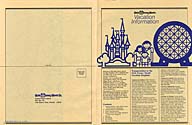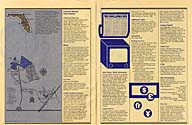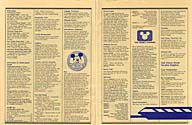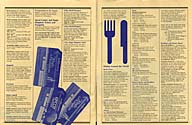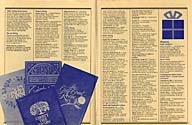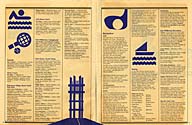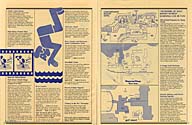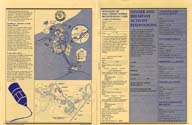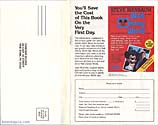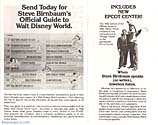Walt Disney World Resort
Part 1 - Overview and History
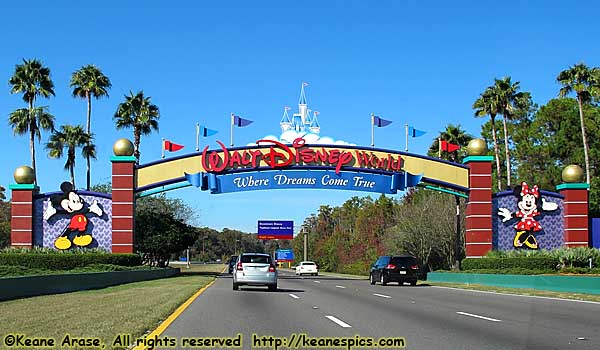
|
| Welcome Home! |
History
Well, sorta. We'll start with my history, if only to show that everything I write here might be biased. Then the Cliff Notes for the Reader's Digest Condensed Version of the history of Disney World and Walt Disney World, which were never the same thing, but in the end became very similar. I sometimes wonder if the Walt Disney World we know today isn't the practical version of Walt's Community of Tomorrow...
My history
My history with Disneyworld sorta starts in 1977, when I was there for a week, and stayed at the Contemporary, one of the two hotels on-property at the time. Yes, someone else paid for it, so I have no idea how much it cost. However, the most vivid memory I have was opening the door to leave the room and seeing the monorail parked at its station across the atrium. (That means a Bay Lake view room, probably on floor 4, 5 or 6... But that was decades ago, and those brain cells have been dead for years.)

|
That might explain why I don't remember a lot of that trip. The four main things I do remember (and left a lasting impression on me), was the heat, humidity, expense and crowds.
Since that trip, I didn't visit another Disney park for 23
years. Too busy with school, then work, and vacations were for
finding good
fishin' holes
and doing Road Trips
out West...
In March 2000, I was going to be in Orlando on business. (Actually, I'd be at a hotel on International Drive, right next to the Orange County Convention Center.) Coincidentally, a couple of people I knew from Chicago were going to be at a reunion of sorts in Tampa the week before, and there was a three day gap between their reunion ending and my conference starting. Hmmm... What to do... Since we were going to be in the neighborhood, how about Walt Disney World! By this time I had already stopped flying, and was going to turn the conference into a Road Trip anyway, spending a few days taking one route to Orlando, and another on the way home. Adding in a few extra days wouldn't be a problem. It was a perfect storm to get me to the theme parks.
And thus, I booked a room on US-192. We'd do Disney World in three days. All the planning was left to the people I'd be there with.
My two previous experiences with Disney Parks, Disneyland in 1969 and Magic Kingdom in 1977 (which was nothing more than an extravagant copy of Disneyland) left me a little cynical about what I was going to see. As I look back, I can't honestly say what I expected in March 2000, but it was more negative than positive. Mediocre to bad (and expensive) food, and an environment more suited for kids. I mean, it was Disney, right?
Well, the cynical side of me was wrong. Disney is after your money, but they're doing it in more subtle ways than just charging you more for everything.
For instance, very attractive (relatively speaking) vacation package prices, including options such as food credits, which allows families to prepay the majority of their vacation. Knowing what the vacation is going to cost upfront makes the decision making much easier. Souvenirs, extra of course. Disney even solves the problem of having to get to and from the airport to one of their resorts by providing "free" bus and luggage transportation. As a matter of fact, the family doesn't even have to touch their luggage at the Orlando Airport, it is automatically routed to their resort by special luggage tags sent to you by Disney. Disney will also provide a free and (usually) efficient resort to park to resort transportation system.
How does that make sense? Volume, to the tune of 50 million visitors per year and almost 30,000 rooms on Disney World property. In addition, this essentially keeps you captive on on-site for your entire trip, and almost all the dollars you spend is with Disney. However, in Disney's defense, Disney makes sure there's very little reason to leave their property, even if you're staying off-site and just visiting the parks.
I also found the food quality was dependent upon price (which is true anywhere), but prices were on-par with other captive venues I've been at. Some of the National Park System falls in this category, those places where there is no nearby food or lodging establishments, such as the Grand Canyon, Yellowstone, Bryce Canyon, Glacier and Yosemite, among others. And it's rare that I've had a meal inside a National Park that I've described as better than just okay, where the food at WDW and the resorts generally ranks pretty good to want-to-lick-your-plate-clean delicious. (However, I do admit that a view of the Grand Canyon or the Grand Tetons outside the window can make up for a lot of shortcomings.)
(I once did a cost comparison with one of my road trips out West to
a Disney World trip, and not counting souvenirs (and my trips out
West will top Disney World in that department), came to less than
a couple dollars per day of each other. The lodging and food expenses
are about equivalent (compared to a moderate resort), and while the
park entrance (and tour) fees on a road trip are 20 to 25 percent of a
Disney World pass, it is made up for by the gasoline and oil change
expenses on a road trip. This was for two people.)
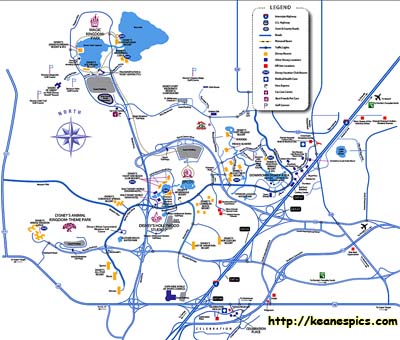
|
| Map of Walt Disney World Resort. Click on the map for a larger view. (1500px x 1250px, 268K.) Map ©Disney |
What was really impressive was the quality, detail and design that went into the parks. The three parks I hadn't been to kept it's Disney roots in many ways, but was as different from one another as one could imagine. It's sometimes very subtle, and may not register on a conscious level, but the tricks and techniques Disney uses in their design has a definite influence on how you perceive your surroundings. (See the recommended books at the bottom of this page.)
Then a friend of mine who had moved to Tampa several years before, drove down to Orlando one night and we went into Epcot. I was amazed at the change of character the park had at night. It also introduced me to Disney Fireworks, Illuminations 2000, Reflections of Earth (the new nighttime show in Epcot at the time) truly took my breath away, with a moving score and (almost) perfectly timed visual effects.
Well, like anything else that interests me, I started investigating Disney World. This was a lot harder than one might imagine today, but in the Web's infancy, detailed information was still hard to come by. Most of it just came in the form of a printed word, rather than electronic bits.
And so, I was back in Central Florida three months later and spent the better part of two weeks practicing my videography in the parks. And then again in June 2001, when I was doing an East Coast Road Trip from Maine to Florida. Well, if you turn right at the Kennedy Space Center, just an hour away is Disney World. Another trip in March 2002, and again in September 2002, when I finally finished off the kool-aid and stayed at a Disney Resort, if only to let Disney do the driving after the parks closed. It was also that trip that I decided digital cameras met my expectations of 35mm film. Then a couple of quick trips in 2003 where I stayed at Animal Kingdom Lodge for the first time, and the other trip was just a couple, maybe three day stop on the way to Key West. I could only make it once in 2004, and decided I had to go back in 2005 to economically justify my annual pass from 2004...
Addiction. It's a terrible thing.
Shortly after starting to stay on-property (that is, in Disney owned resorts), my view of Walt Disney World evolved again. I no longer have to storm the castle (so to speak), and one of my main goals at Disney World is usually to relax. No, that sometimes doesn't happen, it depends on the trip. A D23 event will keep you involved all day, but otherwise I'm rarely in a park at opening, since I think the parks come alive at night. So I tend to stay late at the parks and sleep a little later in the mornings. And then there are the mid-day breaks, usually to get out of the intense afternoon sun and heat...
An increasing number of trips lately have been to attend a D23 event. (D23 is Disney's official fan club and directly supports the Disney Archives.) These events have given me access to Disney Legends, the Cinderella Castle Dream Suite, dinner in Great Movie Ride and a number of backstage tours; as well as the history of Walt Disney World at the 40th anniversary event, and even more detail at Epcot's 30th anniversary event. All of these events have been documented in my Trip Reports.
Also in the years since my return to the resort, my understanding of Disney World has gone beyond just a vacation destination to a study of how a complex system grows and evolves. It's not that hard to guess what's going on if you understand how Disney thinks. (That is, nothing is impossible unless it defies physics, is too expensive or impractical or perhaps too dangerous to the guests (that's you and me), but even then you might be able to do something to fool the guest into thinking it might be possible.)
Let's face it. Walt Disney World has been in existence for over four decades now
(Disneyland almost six), and is still the most attended vacation destination
in the world, perennially takes four of the top five theme park attendance spots
in America (Disneyland rounds out the top five) according to those who keep records.
Disney World
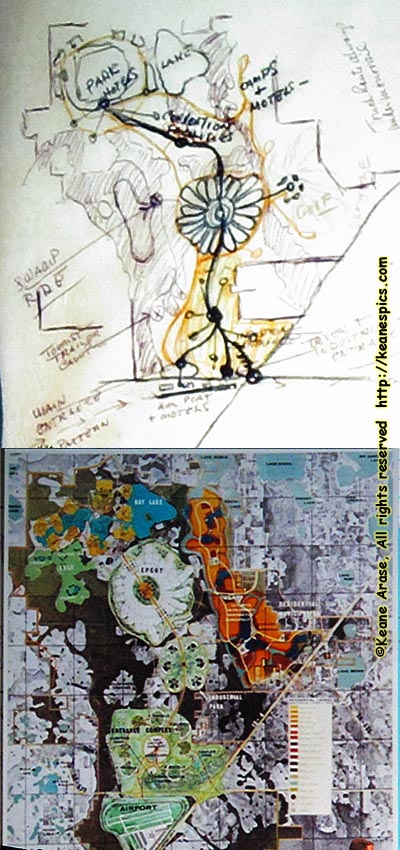
|
| Walt's "Florida Project". The top is his hand drawn map, with a more refined version further into the planning below. (Taken at D23's WDW 40th anniversary event.) |
Before we can talk about Walt Disney World, we should probably talk about what Disney World was supposed to be.
Walt Disney's vision of his "Florida Project" (or "Project X") was quite different than what we have today. Walt wasn't really concerned about creating a "Vacation Destination" as it currently exists. Walt's plans went far beyond just theme parks.
He wanted a city. He wanted an Experimental Prototype Community of Tomorrow.
But let's back up a little. It's true that he thought there should be some place that you could take your kids and spend the day together, and made the monumental decisions to create this Theme Park in Disney's name called "Disneyland". (Against the advice of the current day amusement park executives, who said the park would be too expensive to build and operate.) His mistake (well, his biggest mistake) was not to buy more land when it was cheap and available. Of course, the Disney name didn't have the gravitas it does today, and funds were tight back in the 50's...
So right outside his park, were seedy motels, neon signs and other venues that he didn't like, and didn't want to have associated with the Disney name. Even to this day, while the Disney Company has acquired more of the land around Disneyland, there are still tall walls around some of the areas to block the view of the buildings right across the street. (Of course, tall walls at Disney are themed walls...) I think it's one of the things that make the California parks seem more claustrophobic to me than the Florida parks.
So his plan was to re-do his park right, and correct all the "mistakes" that he made with Disneyland. But where to build this new park? Walt scouted quite a few places looking for a place to build, and it's said that once seeing the intersection of I-4 and the Florida Turnpike from his plane, the decision was made. (Well, that Buzz Price's recommendation on where to place Disney World. Buzz was the one who also recommended where to place Disneyland.)
But something caused his plans to change, something expanded his vision
beyond just an East Coast theme park. If I had to guess, it was the 1964 World's Fair.
He still wanted to build his new park where he had the land to expand
and control the surroundings, but he wanted something more. He wanted
a city. Or more precisely, a City of Tomorrow. Walt's vision of the ultimate
planned community.
With the phenomenal success of Disneyland, his attractions at the World's Fair and successes in other areas, such as the movie Mary Poppins, Walt Disney by 1964 was a very hot property. He knew what would happen if word got out that he was going to buy a lot of real estate, the price of the land would escalate out of control. So he set up seven dummy corporations and bought some 43 square miles of swampland (well, some of it, well, a lot of it) for five million dollars before the newspaper figured it out. Within days, the value of the land around the property increased in value five-and-a-half times, from around $180 to $1000 an acre.
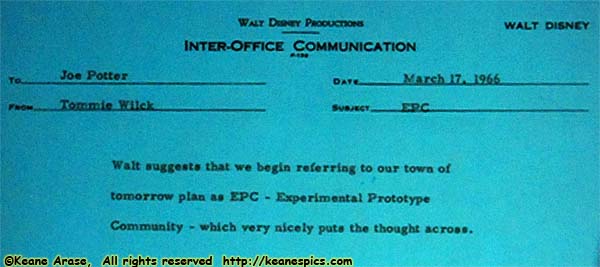
|
| The Memo. (Taken at D23's WDW 40th anniversary event.) |
Walt suggests that we begin referring to our town of tomorrow plan as EPC - Experimental Prototype Community - which very nicely puts the thought across.
He would build the theme park resort first, his Disneyland "done right" (or at least, "themed more efficiently"), and use the profits (not to mention corporate sponsorships) to build his Experimental Prototype Community Of Tomorrow.
Of course, Walt's dream of a city was never realized after his death. It's a place that only exists in films and books, the Disney Archives, and maybe the People Mover in Magic Kingdom. Had Walt lived, I think my narrative from here forward, would have looked much different.
Walt Disney World
Walt may have been an inventor, entrepreneur and visionary, but if he had any serious problem, it was the lack of an heir apparent. He gave directions personally to his teams, and personally oversaw his movies and other endeavors. So when he died on December 15, 1966, he left a void at the company that would have sunk it had it not had its prior successes. The creativeness was still there (it's not like WED and his animators died with Walt), but it lacked the focus and direction of Walt Disney. (Not to mention the charisma it took to seek venture capital, to be honest.) You can complain about the bureaucracies of some of the decision making today, but much of it was done so the loss of one person wouldn't cause the company to come to a complete halt.
I think the biggest casualty of Walt's death (if you look at the different assets within the company), was Disney World. The company had only acquired the land a year before, and everything was in its infancy and planning stages. Marty Sklar (now retired), who I think was probably Walt's spiritual (if not actual) successor in Imagineering's Theme Park business, said succinctly, "And then the Disney world we knew imploded."
There was no one else in the company that had the charisma and entrepreneurship of Walt, who could raise the capital and have the will to create his plan. The plans for Disney World were put in a box. Roy O. Disney said it was so far beyond the scope of what the company did, that he couldn't even comprehend it. The Board of Directors decided it wasn't in the best interest of the company to try to run a city. Of course, more than a few of Walt's decisions probably weren't in the best interest of the company, but it's hard to argue with the Board's decision when you look at the world-wide multi-media corporation the Disney Company has become.
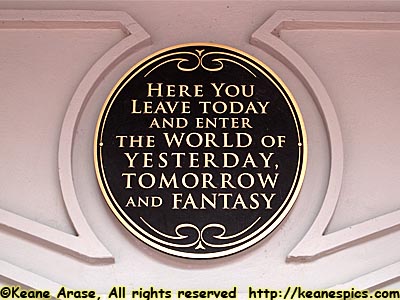
|
| At the entrance to Magic Kingdom. |
But in 1967, the company still had 43 square miles of undeveloped land in Florida. By 1968 the company had the Florida Supreme Court pretty much confirm that the Reedy Creek Improvement District (the governing body that oversees Walt Disney World's land) was an entity unto itself, and could do whatever it wanted within its borders. Rumor has it they could have even built a nuclear reactor on-site.
Since the theme park and hotels were part of the first phase of the
Florida project, they were already semi-planned, and their locations
were determined even in the early sketches above. Soon after the
establishment of the Reedy Creek Improvement District (or RCID),
swamps were drained and construction began.
On January 16, 1970, Disney opened a Preview Center, a place where the public could go and see what the Mouse was up to. It closed on October 1, 1971, the day Walt Disney World officially opened. ("Walt" was added by Roy as a tribute to his brother.) It consisted of Magic Kingdom, the Contemporary Hotel and the Polynesian Resort, all connected by monorail and boat to the Ticket and Transportation Center, where you parked your car and left "today" behind, and entered the world of Yesterday, Tomorrow, and Fantasy.
In 1974, Marty Sklar (the new creative leader at Imagineering) got a call from Card Walker (CEO of Disney at the time) who asked, "What are we going do about EPCOT?" Epcot Center (and later just Epcot), half technology showcase and half World's Fair, opened on October 1, 1982.
In 1984, Michael Eisner is hired as Disney's CEO. He's seen the plans for Universal Studios Florida (now Universal Orlando) in a former job, and Disney-MGM Studios (now Disney's Hollywood Studios) opens on May 1, 1989, a year before Universal.
In 1990, Eisner declares the Disney Decade, and on April 22, 1998 Animal Kingdom officially opens.
(The individual theme park pages have a more expanded view of events. There are a series of construction photos, as well as a series of attractions and other venues that no longer exist, from a presentation by Dave Smith, in my May 2011 trip report.)
There are rumors of another park (maybe more than just rumors, this is the longest
interval between park openings yet), and with the acquisition of what is now a wildly
successful Marvel and two of the most successful franchises in movie history with Lucasfilm,
creates some fascinating speculation. (Universal Orlando has exclusive rights to the
Marvel characters in the Florida Theme Park world, but is apparently going to give them up.
If you were Disney's biggest competitor in the Central Florida, would you
want Disney characters in your park? But I digress...)
| The four theme park icons. |
In addition to the four theme parks, Walt Disney World today can boast:
- A shopping district, Downtown Disney, with a soon to be renovated nightclub district called The Springs.
- Two water parks, Blizzard Beach and Typhoon Lagoon.
- Two miniature golf courses, Fantasia Gardens and Winter Summerland.
- Five real golf courses, Oak Trail, Magnolia, Palm, Osprey and Lake Buena Vista.
- A complete sports and training complex, ESPN Wide World of Sports.
- A campground, Fort Wilderness, with 800 campsites and 400 cabins.
- A residential home area, Golden Oaks, with around 400 homes.
- Up to 26 Disney owned hotel resorts (depending on how you want to count things) with somewhere around 27,500 rooms, just a couple thousand less than downtown Chicago. (There's a better breakdown on the Resorts page. And that number doesn't count the 10 non-Disney owned hotels on Disney World property, such as the Swan and Dolphin, Shades of Green, Hilton, Best Western, etc.)
In the end, Walt Disney World isn't the Disney World Walt imagined it would be. Would he have been disappointed? Perhaps. I'm sure he would have been in the early 80's when another theme park, even as grandiose and ambitious as it was, replaced the city of his dreams.
But if Walt could see his Florida Project today, I'm sure he'd be amazed to see what his company has accomplished. The Disney Company has built a vacation destination with a population (albeit a transient population) bigger than most cities in America, with an infrastructure larger than those cities to support it, including water, sewage, garbage disposal, transportation and power. It's somewhat staggering to think of what it takes to supply and maintain things like food services; complete hotel operations for 26 hotels; the vast bus, boat and monorail transportation system; plus four major theme parks with dozens of different attractions.
So no, the Disney Company didn't build Walt's City of Tomorrow, but his successors did build a city, where buses and boats replaced monorails and peoplemovers, theme parks replaced industry and hotels replaced residences, all to the tune of some 51 million guests entering the parks per year.
So even if Walt was disappointed in what Walt Disney World has become, he most certainly would have approved of the success his East coast resort has had for the past 40 years. After all, Walt thought the ultimate praise was how well the audience liked your work.
Size of Disney World versus Disneyland
And here's an interesting overlay of the size of Walt Disney World versus Disneyland Resort.
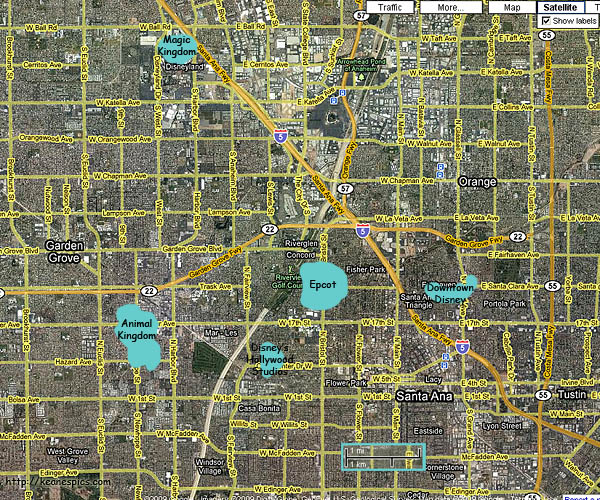
I went to Google and got a map of Walt Disney World, then a map of Disneyland Resort to the closest scale. The Florida map was re-sized to the same scale as California.
The Florida Theme Parks were matted out, and overlayed on California, the Magic Kingdom
centered over Disneyland. Walt Disney World is a big place...
Map ©Google and a bunch of others.
Walt Disney World Preview Edition
This was the preview guide handed out at the Walt Disney World Preview Center, which opened January 16, 1970, and closed the day Walt Disney World opened. At least I assume it was handed out, I mean, this is Disney. It could have cost 50 cents. (If you look on page 19, you can order additional copies for 65 cents, which includes postage...)
This Preview Edition is a copy from the Disney Archives, a perk handed out with your registration for Destination D: Walt Disney World 40th, D23's celebration of WDW's 40th birthday. It was a two-day event that covered WDW from the 1964 worlds fair through Epcot.
It's interesting to read about the future plans which never came to fruition...
1970/1971 Walt Disney World Preview Edition
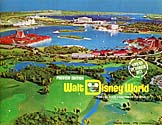
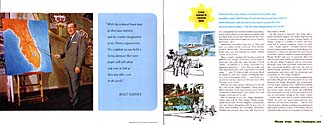
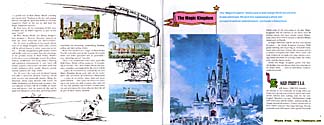
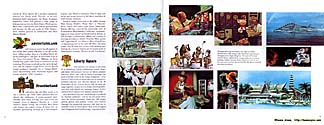
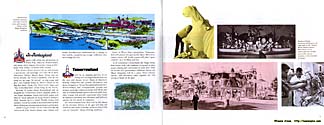
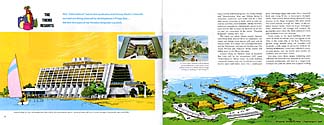
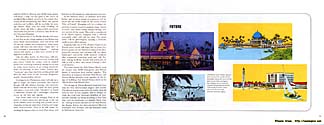
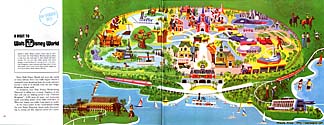
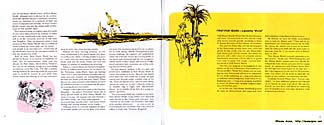
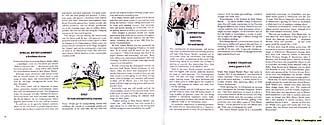
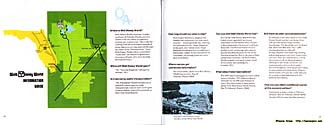
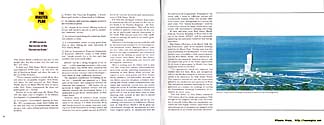
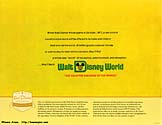
Walt Disney World, 1983 Vacation Guide
Before there was an internet, there was paper. Well, even after the internet there was paper for a few years. Disney finally discontinued almost all paper based promotional material years ago, when (almost) everyone had internet access. Then it was a huge cost savings in disguise of environmentalism. Gotta love it.
So how did you plan a Disneyworld Vacation 40 years ago? You got brochures like this one.
This is a Walt Disney World Vacation Guide from 1983. How do I know it's from 1983? Because of an "Orlando TV Tempo Hotel Edition" TV guide from May 28 thru June 3, 1983 that were stuck in the pages. You can see where the cheap pulp paper of the TV Guide yellowed pages 10 & 11 of the Vacation Information.
I've segregated the "Vacation Guide" and the "Vacation Information", but they were attached with a common center staple (as was the Birnbaum Insert), but they're essentially two different documents.
1983 Walt Disney World Vacation Guide

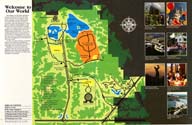
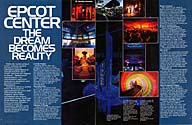
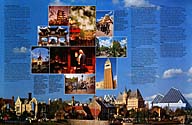
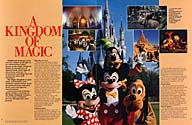
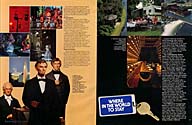
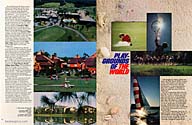
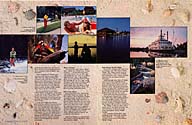
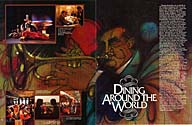
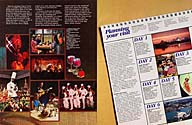

1983 Walt Disney World Vacation Information
Birnbaum Insert
It's probably not good anymore for that price. I should try sending it in...
Recommended Reading
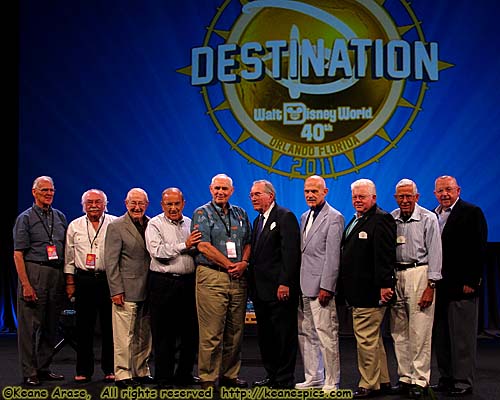
|
| 10 of the Disney Legends that created Walt Disney World. (Taken at D23's Walt Disney World's 40th Anniversary.) |
The first is Dream It! Do It! by Marty Sklar. Marty's had more than his hand in the creation of all the Walt Disney World theme parks. You'll also find that early in his career he was the main ghost writer of Disney's press releases and promotional films, so his story goes far beyond just being the head of Imagineering. But there's a lot of information about the creation of the parks in this book.
The other is Designing Disney by John Hench. It's almost a handbook on "The Art of the Show", or how some of the design decisions, from architecture to shapes to colors to characters in the Disney Parks are made or considered. It could almost be looked at as treatise on Disney Mind Control in some ways, with descriptions on how choices were made to influence the guest's mood and perception. And the artwork within is worth the price of entry, from concept art to personal sketches. (John Hench is also the official portrait artist of Mickey, and are included at the end of the book.)
You may also want to check out the two Imagineering books,
oversized coffee-table sized tomes full of Disney Eye Candy, as well
as a look at what Imagineering actually does. They are
Walt Disney Imagineering: A Behind the Dreams Look At Making the Magic Real and
Walt Disney Imagineering: A Behind the Dreams Look at Making More Magic Real.
They're both beautifully done books.
"Well... We're on the air. They want me to say something. We're wasting film, I know, I can't think of what to say." -- Walt Disney, July 1956
End Walt Disney World (overview) - Part 1 of 3.
| Jump to: | Part 1, History | Part 2, Brain Dumps | Part 3, Pictures and Overview |
|---|
- 05/15/2010 - Pictures added, some cleanup
- 05/07/2012 - Updated to v3
- 12/31/2012 - Update to v3.1
- 01/18/2014 - Rewrite
- 09/01/2014 - Update to v3.2
- 06/10/2015 - Page split
- 06/21/2015 - Rewrite and update
- September 2022 - Upgrade to v5.0.
| Help! | About This Site | Contact Me |

